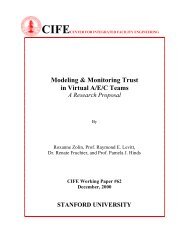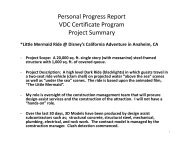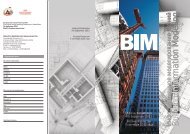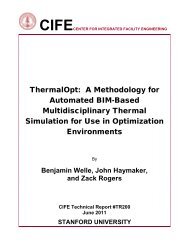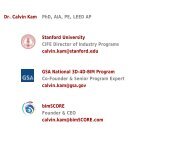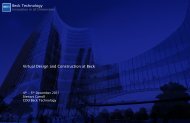Framework for Measuring Rationale Clarity of AEC Design Decisions
Framework for Measuring Rationale Clarity of AEC Design Decisions
Framework for Measuring Rationale Clarity of AEC Design Decisions
Create successful ePaper yourself
Turn your PDF publications into a flip-book with our unique Google optimized e-Paper software.
<strong>Framework</strong> <strong>for</strong> <strong>Measuring</strong> Rational <strong>Clarity</strong><br />
Page 15 <strong>of</strong> 22<br />
spaces to mean the corresponding analysis was not conducted, was not applicable, resulted in a<br />
prediction <strong>of</strong> an option having zero effect on a building, or was erroneously omitted.<br />
Concrete/Vague<br />
Assertions that are coherent may be concrete enough to convey objective meaning, or may be<br />
open to subjective interpretation. Concrete assertions state data in explicit terms requiring no<br />
additional project knowledge to understand. Exactly those distinctions meeting the “clarity test”<br />
from decision analysis meet this definition <strong>of</strong> concreteness (Howard 2007). By contrast,<br />
assertions that (to the source) seem conventionally understood but have no concrete definition<br />
allow <strong>for</strong> misinterpretation. Only coherent data can be defined as either concrete or vague; in a<br />
sense, incoherent assertions are objectively identifiable as a complete failure to communicate,<br />
whereas vague assertions do carry in<strong>for</strong>mation that is are vulnerable to subjective interpretation.<br />
As an example, the assertion, “The steel structure’s materials cost $10M” is concrete because the<br />
exact cost <strong>of</strong> materials can be objectively determined and compared with $10M. In contrast, the<br />
assertion, “the steel structure’s materials are expensive” is vague because people may view the<br />
materials as expensive when comparing to the building’s other structural option, but as<br />
inexpensive when comparing to steel used <strong>for</strong> another building.<br />
Connected/Disjoint<br />
Multiple coherent assertions that share common terms and presentation are termed connected.<br />
Connected assertions relate data directly and meaningfully to other assertions, without requiring<br />
additional analysis, insight, or expertise. Typical design documents contain many connected<br />
assertions in rhetorical, tabular, or visual <strong>for</strong>mats. Assertions from multiple components are<br />
more <strong>of</strong>ten disjointed.<br />
The definition <strong>of</strong> rationale clarity includes a notion <strong>of</strong> connectedness between data because<br />
decision-making requires assertions’ synthesis. Making implicit knowledge explicit is necessary<br />
<strong>for</strong> integrating multiple perspectives into a single decision basis. Narratives (Haymaker 2006)<br />
provide one generic means <strong>for</strong> representing the connections between multiple sets <strong>of</strong><br />
in<strong>for</strong>mation.<br />
Consistent/Contradictory<br />
Any set <strong>of</strong> connected, concrete assertions can be evaluated <strong>for</strong> consistency. Consistent assertions<br />
are mutually compatible; no reasonable interpretation can support contradictory assertions. For<br />
example, the assertions, “The Master Suite will be on the second story” and, “The residence will<br />
have only one story” are contradictory.<br />
Only connected data can be considered consistent. Disjointed data cannot be compared to<br />
ascertain where any contradictions may lie. Additionally, only concrete data can be consistent or<br />
inconsistent. To the extent that an assertion is vague, it carries no objective meaning that relates<br />
to other assertions. For example, the assertion, “The steel structure’s materials cost $10M.<br />
Labor raises the total cost <strong>of</strong> the steel structure to $8M” is contradictory because $8M is less than<br />
$10M. In contrast, the assertion, “The steel structure’s materials cost $10M. Labor raises the<br />
total cost <strong>of</strong> the steel structure to $18M” is consistent <strong>for</strong> labor costs <strong>of</strong> $8M.<br />
©2010 John Chachere & John Haymaker




